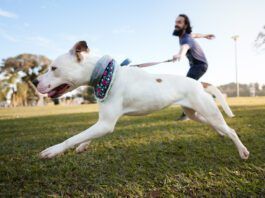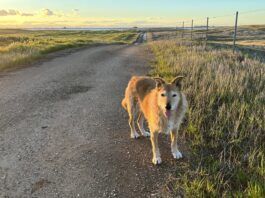New Age
I recently had the great pleasure of meeting and interviewing Karen Pryor, who, more than anyone else, pioneered and popularized force-free animal training with the publication of her 1985 book, Don’t Shoot the Dog! At nearly 81 years of age, Pryor continues to inspire people in every behavior-related field to give these kind, respectful techniques a try.
End of the List?
Like any old fight, it’s hard to recall all the details. Suffice to say that, many years ago, when we agreed to make it a convention to publish a review of dry dog foods every February, my boss (publisher of WDJ) and I argued for hours about whether or not I had to prepare a list of “approved foods” to accompany the article. It’s become the number one feature in WDJ that readers cite as their reason for subscribing, so it turns out that my boss wins the argument. But I hate the list. I really, really haaaaaate it. Why? Let me describe my top four reasons.
Useful
Cowboys are typically laconic, but I never forgot the one-word summation of the well-known reined cowhorse trainer in reference to a colt I was working with many years ago. He watched closely as I put the colt through his paces: walk, trot, lope, reverse directions, and smoothly slide to a stop. I was pleased with the colt’s work that day; he was willing yet relaxed, engaged, and seemed appreciative of the strokes I gave his glistening coat as we walked over to the rail to talk to my trainer acquaintance. “What did you think of him?” I asked. The far more experienced horseman squinted and paused before he responded. “Useful,” he drawled. I must have looked disappointed, because after a moment, the trainer elaborated. “Yep, he looks useful . . . . That’s a damn fine colt.”
Smallville
The first small dog I ever owned came to me as a hand-me-down. My sister’s husband brought home a long-haired Chihuahua puppy on a whim, but after the initial “new dog” thrill wore off, no one in the family took the time or had any interest in training the tiny dog. Mokie grew up eliminating in the house, chewing anything that interested him, and barking shrilly at everyone who came to the door. If they took him outside, he had to be on a leash, because he would gaily run down (and into) the street any chance he got, and no amount of calling would bring him back until he was exhausted. When I first met him, he was almost a year old and knew nothing. He responded to his name – sometimes – but didn’t know how to perform a single behavior on cue. When I asked what behaviors he knew, my sister responded with a tone that indicated I was being ridiculous for asking. “Oh right,” she said. “Like you can even train a dog that small.”
Prime Time
Time flies when you love dogs, and not in a good way. Otto, the canine love of my life, turns five years old this month. Of course, since he was a stray and I adopted him from my local shelter, I don’t know his exact age; he was estimated to be about 7 months old when I adopted him in June 2008. So we assigned him the birthday of November 1, 2007 – which would make him 5. Where has the time gone?
New or Used?
Recently, one of my friends bought a puppy. Don’t judge! She did everything right: She is familiar with the breed, she researched the breeder thoroughly (including references from past puppy buyers), and had the results of veterinary exams and xrays in hand before picking up the pup. It was immediately apparent that the breeder had done everything right, too. Super socialized and well-adjusted, the puppy settled into my friend’s home like he had lived there his whole life, handling his interactions with her mature dogs, cat, livestock, and human visitors with confidence and grace. Yes, grace. He is calm, friendly, playful, and inquisitive. He learned basic behaviors like “sit” and “wait” quickly and easily. His new owner is thrilled with him, as she should be.
Rattled . . .
I live in a small town that is surrounded on all sides by either farm land (west and south of us) or foothill woodlands. The historic center of this Gold Rush-era town is located on the banks of a river, and thanks to a large state water project, including a huge dam and lake just above the town, and a man-made recreational lake just below town, there are miles and miles of trails on public lands adjacent to all that water. It’s heaven for an off-leash dog walker like myself. Except, of course, there are hazards aplenty that can befall a dog who lacks training and/or common sense. A dog without a solid and well-proofed recall could disappear without a trace if he chased a deer or rabbit or other critter off into the woods.
What It Takes
Back in May, I wrote a blog post on Whole Dog Journal’s website (wholedogjournal.com/blog) about a little dog named Mickey. He was surrendered to the shelter where I volunteer in June 2011; his age was estimated at 5 months. He’s a strange-looking, high-energy mixed breed dog with a docked tail and floppy ears; at admission, the shelter staff guessed he was a Pug/Chihuahua-mix, but as Mickey matured, his legs grew and grew. Today my guess would be a Chihuahua/Fox Terrier-mix. He’s so unusual-looking, and so bouncy, that it took a full six months to find someone to adopt the little guy – and the adoption lasted just three months. To the dismay of the shelter staff, he was returned to the shelter at the end of March; the stated reason was that the owner’s original dog was picking on Mickey unmercifully.
Tea Time
A bout 12 years ago, my aged Border Collie, Rupert, developed a serious cardiac condition: ventricular tachycardia. The cost of the diagnostics and treatment was expensive, but less than half the price at the vet school at the University of California, Davis, than it was at the office of my local veterinary cardiologist, so Rupe and I made the three-hour (round-trip) drive from our house in the San Francisco Bay Area as often as we needed.
Summer Reading
This month, as I was putting the finishing touches on the issue you are reading right now, I happened to see a childhood friend announce (on Facebook) that she was at her veterinarian’s office on an emergency with one of her three Rat Terriers. I wrote to ask what was wrong, and she said that Miley (one of the three) had diabetes, and that his glucose level dropped too low; they needed veterinary help to get him stabilized.
Inter Nyet
This issue contains, among other things, an in-depth article about canine diabetes. WDJ’s ace team of canine health researchers/writers, CJ Puotinen and Mary Straus, have spent months researching this vexing (and increasingly common) disease in dogs. What causes diabetes? What’s the best treatment for it? What should I feed my diabetic dog? They’ve reviewed veterinary texts and reference materials, analyzed the latest studies, and have distilled what they learned into sound, practical information for you.
Dogs Talk . . .
Today’s viral video was of a news anchor who was bitten in the face by a dog on live television. If you own a dog, you probably either saw the video, read an article about the incident, or heard other dog owners discussing it. But dogs bite people every day; why was this incident so riveting? Well, for one thing, the dog was on TV because he had been rescued from near death (in an ice-covered pond) only the day prior. There was gripping video footage of the rescue – a handsome young firefighter went into the icy water and hauled the 85-pound dog to safety.















